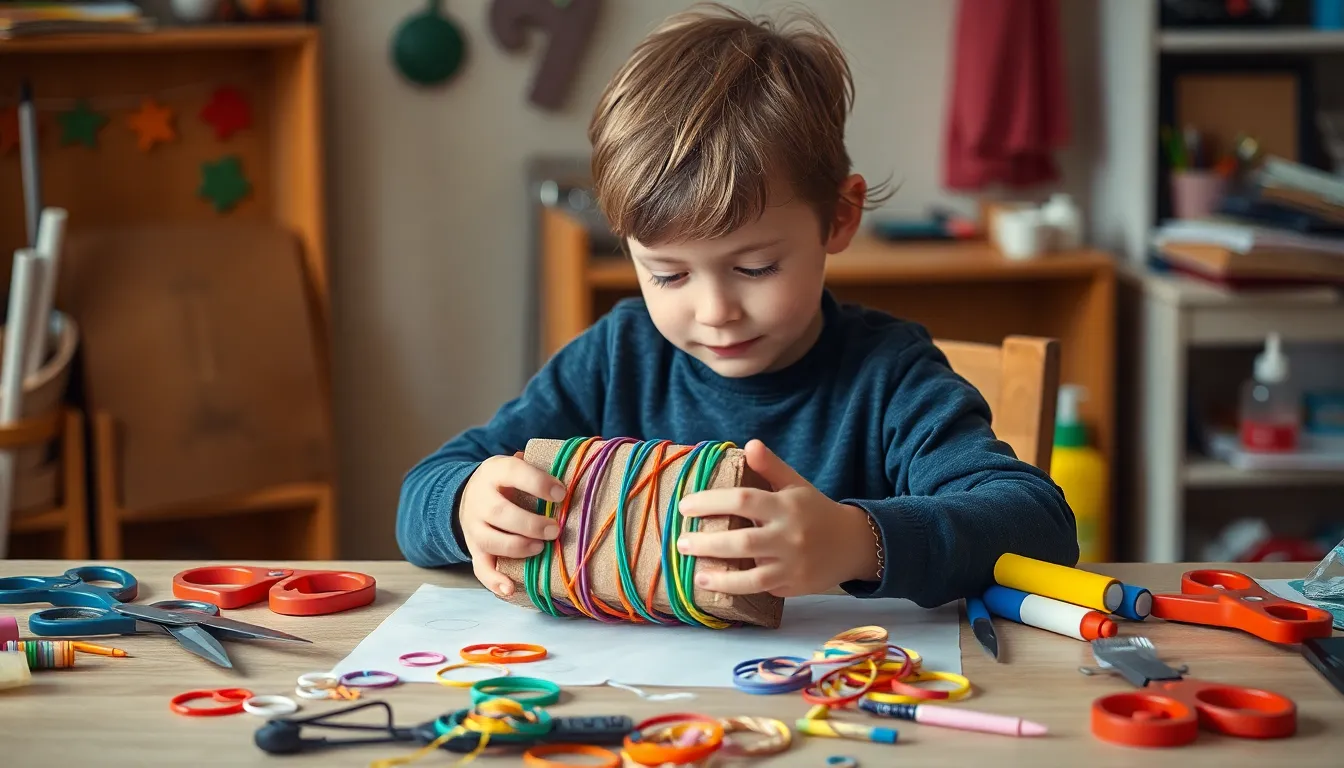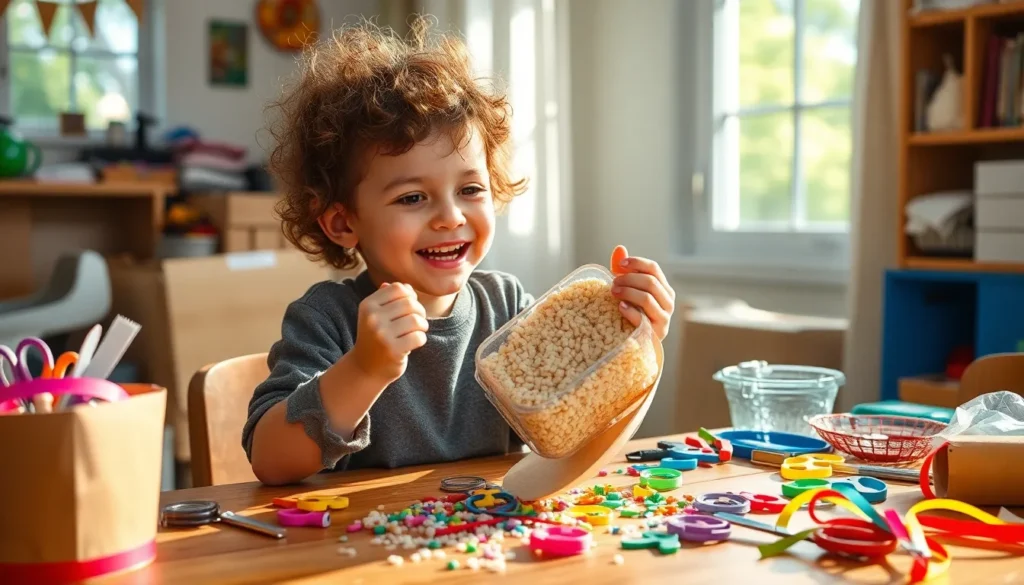Imagine a world where your living room transforms into a symphony hall, courtesy of your little ones and their DIY musical masterpieces. Crafting musical instruments isn’t just a fun afternoon project; it’s a gateway to creativity, learning, and a whole lot of noise—much to the delight (or dismay) of parents everywhere!
From simple shakers to elaborate string creations, kids can unleash their inner rock stars while honing fine motor skills and understanding sound. Who knew that a few household items could turn into a maraca or a kazoo? So grab some glue, a few odds and ends, and let the musical chaos begin! It’s time to make some noise and memories that’ll last a lifetime.
Table of Contents
ToggleOverview of DIY Musical Instruments for Kids
Creating DIY musical instruments offers a valuable opportunity for kids to explore sound and rhythm. Parents can facilitate this process by providing everyday household items. Shakers made from rice-filled containers or string instruments crafted from cardboard and rubber bands serve as excellent starting points.
Children actively engage in the crafting process, enhancing their creativity and understanding of music. They learn about different sounds produced by various materials. Building instruments also helps to develop fine motor skills as kids manipulate objects and connect components.
Some popular DIY instrument ideas include:
- Shakers: Use plastic bottles filled with rice, beans, or beads. Secure the cap tightly for safe play.
- Drums: Utilize empty containers covered with balloons or fabric. Children enjoy experimenting with different striking tools.
- String Instruments: Create guitars using cardboard boxes and rubber bands. Varying the tension on the bands changes the sound.
- Maracas: Fill cups with small items, like pebbles or pasta. Seal cups with plastic wrap and secure a stick for easy shaking.
- Harmonicas: Stack two popsicle sticks with rubber bands and a piece of paper in between. Kids can blow between the sticks to create sound.
Engaging kids in these activities fosters teamwork and enhances their ability to follow instructions. While building instruments, they discuss ideas and share creative input. This collaborative effort can strengthen family bonds as they share musical experiences together. By nurturing a love for music, parents set the foundation for lifelong enjoyment and learning.
Benefits of Creating DIY Musical Instruments

Creating DIY musical instruments offers numerous benefits for kids. Engaging in these projects sparks creativity, encouraging children to think outside the box.
Enhancing Creativity
Making musical instruments from everyday items allows children to express themselves inventively. They can experiment with different materials like cardboard, plastic bottles, and rubber bands. Each creation serves as a blank canvas for their artistic flair. Not only do they develop unique instruments, but they also explore various sounds and rhythms. The process of building instruments fosters a sense of ownership, as kids take pride in their personalized designs. Crafting these items instills a deep appreciation for music, helping them recognize the endless possibilities in artistic expression.
Developing Fine Motor Skills
As children construct their instruments, they refine their fine motor skills through cutting, gluing, and assembling parts. Each activity targets hand-eye coordination, which is crucial for various everyday tasks. For instance, threading rubber bands or shaping cardboard demands dexterity and control. Engaging in these hands-on projects improves focus and precision, essential skills for future learning. Moreover, the physical manipulation of materials enhances hand strength and coordination. Encouraging kids to create instruments promotes development while they enjoy making music, merging skill-building with a fun, creative outlet.
Popular DIY Musical Instruments
Creating musical instruments at home offers endless possibilities for kids. Many fun projects exist to inspire creativity and learning through sound.
Simple DIY Percussion Instruments
Shakers provide a straightforward starting point. Kids can fill empty containers with rice, beans or beads, then secure the lids. Drums can be made from any empty container, such as a coffee can or cardboard box, covered with balloons or paper as a drumhead. Clapsticks offer another easy option: children can use craft sticks or wooden spoons. Rhythmic patterns and beats emerge as children experiment with different sounds. These percussion instruments not only engage them but also develop timing and coordination skills.
Fun String Instruments to Make
Crafting string instruments stimulates imagination. A simple string can turn a cardboard box into a guitar. By attaching rubber bands across the box, kids can create varied pitches. Additionally, shoeboxes or tissue boxes are excellent for this purpose. Kids can also try making a simple banjo using a jar filled with water and a piece of cardboard for a top. By tuning the rubber bands to different tensions, they explore sound variations. Each instrument nurtures an understanding of the fundamentals of music while enhancing fine motor skills through assembly.
Tips for Making DIY Musical Instruments
Creating DIY musical instruments for kids can be exciting and enriching. Focusing on safety and engagement enhances the overall experience.
Choosing Safe Materials
Selecting appropriate materials is crucial for safety. Choose non-toxic items wherever possible. Recycled materials like cardboard boxes and plastic bottles work well. Avoid sharp edges and small parts that can pose choking hazards. Items like rice or beans can fill shakers, but ensure containers are secure to prevent spillage. Use duct tape to reinforce seams, preventing accidental breaks. Supervision during the crafting process ensures safety and allows for guidance. Emphasizing safe play promotes a worry-free creative environment.
Engaging Kids in the Process
Engaging kids in crafting instruments enhances their excitement. Involve them in selecting materials, sparking their creativity. Allow experimentation with sounds, encouraging exploration. Using hands-on approaches fosters a sense of ownership. Share ideas and offer support while they build their instruments, promoting collaboration. Create a musical atmosphere by playing songs during the making process, inspiring them further. Celebrating their creations adds to their pride, resulting in a memorable experience. Encouraging participation nurtures their love for music while fostering valuable skills.
Creating DIY musical instruments offers children a unique opportunity to explore their creativity while learning valuable skills. Engaging in these projects not only sparks their imagination but also enhances their understanding of sound and rhythm. As kids craft their own instruments from everyday materials, they develop fine motor skills and teamwork abilities.
Parents play a crucial role in this journey by fostering a supportive environment that encourages experimentation and self-expression. Celebrating their children’s creations deepens their appreciation for music and nurtures a lifelong love for it. By embracing these fun and educational activities, families can create lasting memories filled with joy and creativity.





